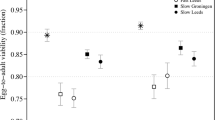Summary
The elapsed time from the appearance of a single copy of a recessive gene in a population with separate sexes until the first detection of a recessive homozygote has been analyzed using simulation techniques. Several systems of mating frequently used in laboratory maintenance and artificial selection processes have been the subject of this study. The expected time of detection (T) in each system of mating is described by a function of number of parents (N) and the factor K that when multiplied by N gives the number of examined individuals per generation (e.g. T=1.6+1.8 (N/K) 1/3 for the mass-mating system). Although the expected time of detection changes greatly depending on the system of mating and on the K value (the causes are discussed), both the time scale (N 1/3) and the coefficient of variation of the distribution of the times of detection (2/3) seem to be unaffected. The additional reduction of the effective population number caused by artificial selection on a heritable trait modifies the expected detection time in a minor way unless both high heritability and high selection intensity are involved.
Similar content being viewed by others
References
Crow JF (1954) Breeding structure of populations. II. Effective population number. In: Kemthorne O (ed) Statistics and mathematics in biology. Iowa State College Press, Ames, pp 543–556
Fisher RA (1958) Statistical methods for research workers. Oliver and Boyd, London
Frankham R (1980) Origin of genetic variation in selected lines. In: Robertson A (ed) Selection experiments in laboratory and domestics animals. Commonwealth Agricultural Bureaux, Slough, pp 56–68
Hollingdale B (1971) Analyses of some genes from abdominal bristle number selection lines in D. melanogaster. Theor Appl Genet 41:292–301
Karlin S, Tavaré S (1980) The detection of a recessive visible gene in finite populations. Genet Res Camb 37:33–46
Karlin S, Tavaré S (1981a) The detection of particular genotypes in finite populations. I. Natural selection effects. Theor Popul Biol 19:187–214
Karlin S, Tavaré S (1981b) The detection of particular genotypes in finite populations. II. The effects of partial penetrance and family structure. Theor Popul Biol 19:215–229
Kimura M, Crow JF (1963) On the maximum avoidance of inbreeding. Genet Res Camb 4:339–415
Robertson A (1961) Inbreeding in artificial selection programmes. Genet Res Camb 2:189–194
Robertson A (1964) The effect of non-random mating within inbred lines on rate of inbreeding. Genet Res Camb 5:164–167
Robertson A (1978) The time of detection of recessive visible genes in small populations. Genet Res Camb 31:255–264
Wright S (1940) Breeding structure of populations in relation to speciation. Am Nat 74:232–248
Yoo BH (1980) Long-term selection for a quantitative character in large replicate populations of D. melanogaster. I. Genet Res 35:1–17
Author information
Authors and Affiliations
Additional information
Communicated by L. D. Van Vleck
Rights and permissions
About this article
Cite this article
Santiago, E. Time of detection of recessive genes: effects of system of mating and number of examined individuals. Theoret. Appl. Genetics 77, 867–872 (1989). https://doi.org/10.1007/BF00268340
Received:
Accepted:
Issue Date:
DOI: https://doi.org/10.1007/BF00268340




